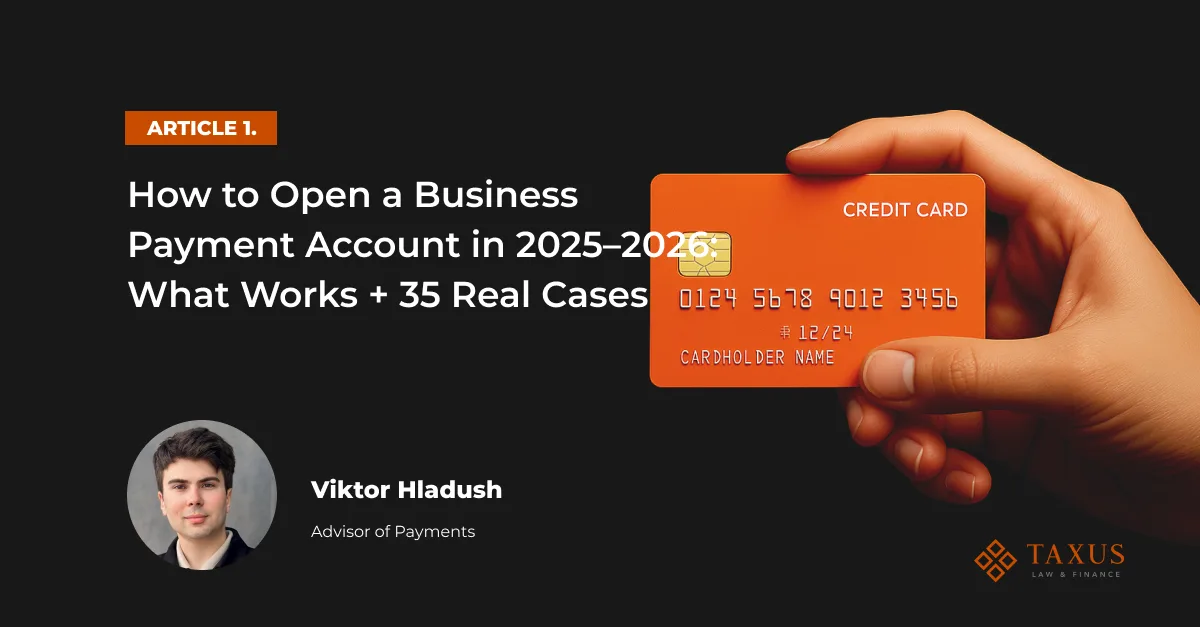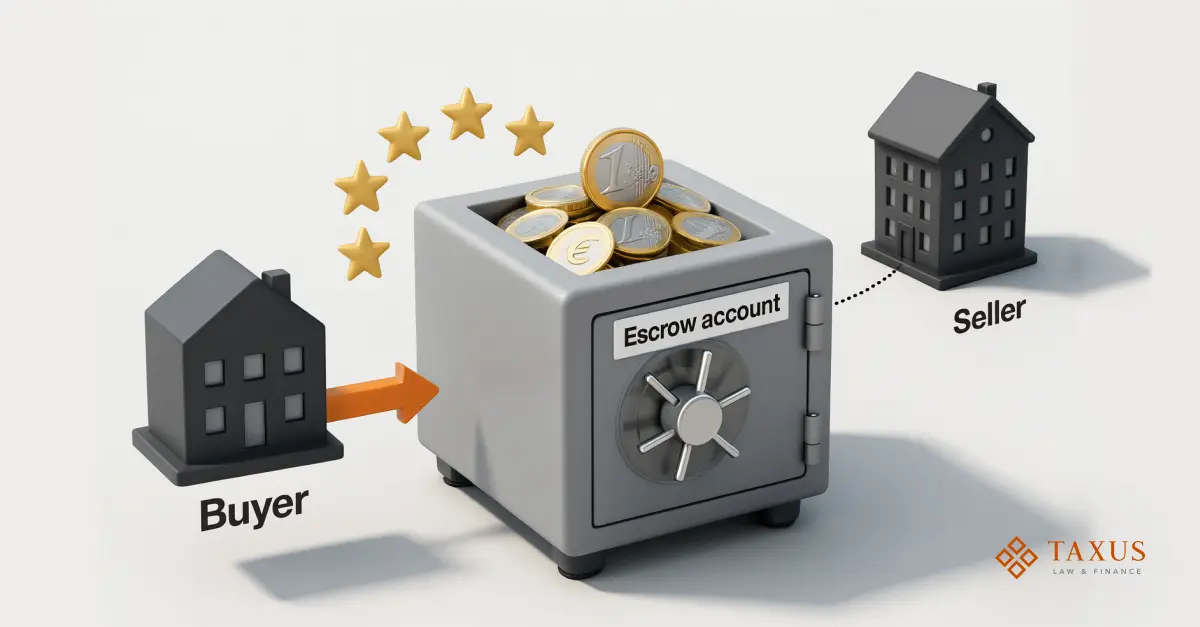How to Open a Business Payment Account in 2025–2026: What Works + 35 Real Cases

V. Hladush

Opening a payment account in 2025 is challenging but entirely achievable. In this series of articles, I’ll detail the key factors that influence successful account openings, explain why banks and EMIs sometimes decline applications, highlight common business mistakes, and show how to avoid them. We’ll start with the fundamental principles and successful cases that have helped dozens of businesses navigate this path with Taxus.
Hladush, and I’ve spent almost five years in traditional banking (Ukreximbank, PrivatBank, BNP Paribas “Ukrsibbank”), and the past two years in international consulting as Head of Payments at Taxus Law & Finance.
During my time at Taxus, I managed over 35 payment account-opening projects — from operational and safeguarding accounts to merchant setups — and helped launch the internal Taxus Banking MVP. Throughout this work, we doubled our network of payment providers and built scalable partnerships with BaaS, Banks, EMI, and PSP networks. We worked with clients from various jurisdictions — including Hong Kong, the UK, Cyprus, the USA, EU, Ukraine, Georgia, and Curaçao — and beyond, covering a wide range of complex industries.
These included:
- Crypto & Web3: custody platforms, OTC desks, regulated brokerage.
- IT & SaaS: export-oriented software and development companies.
- Forex & Trading: B2C brokers and proprietary trading desks.
- Dating & Matchmaking: international platforms, often with CIS founders.
- Media & Marketing: digital agencies, affiliate networks.
- iGaming: regulated gaming projects with global licensing.
- Payment Agents & Licensed Holdings: PSP-licensed businesses, multi-jurisdiction structures.
This series of articles is a summary of real cases, failures, insights, and lessons learned from two intensive years on the front lines of international onboarding and banking relationships.
What is “opening an account” in 2025
In today’s payments world, “opening an account” can mean several things. The simplest is a bank account with a regulated bank. But fintech businesses often need alternative accounts like e-wallets. There are five common “account” types to consider:
- Traditional bank account: A standard corporate checking account with a bank.
- EMI e-wallet: An account with an electronic money institution that holds customer funds (often prepaid or in e-money form).
- Safeguarding account: A segregated bank account required for EMIs and payment firms, where customer funds (relevant funds) must be kept separate under regulation. For example, UK law requires that “relevant funds” received by an EMI must be placed in an account in the firm’s name, ensuring e-money liabilities are backed.
- Client money account (UK/EEA): Under FCA/PSR rules, payment firms may hold a “client money” account for UK/EEA customer funds, subject to protective rules (similar to safeguarding).
- Merchant/PSP account: A merchant acquiring or payment service provider (PSP) account that enables accepting customer payments (credit card, iDebit, etc.). This often requires a separate application and underwriting by payment networks or acquirers.
Each type has different regulatory requirements. For instance, safeguarding and client-money accounts must meet capital and audit rules, whereas merchant accounts involve scheme/KYC approvals. A company often needs multiple accounts (e.g. a main bank account plus an e-wallet or merchant account) to cover all payment flows.
Main misconceptions
There are some persistent myths about opening accounts:
- “Just give me a contact, I’ll get it.” In reality, no contact or bribe can override the compliance process. Providers must satisfy their regulators.
- “If it’s an LTD company, there’s no problem.” Legal form alone doesn’t ensure approval. AML/KYC and risk remain key.
- “You can resolve everything in a week.” In practice, onboarding (due diligence, legal review) often takes months, especially for high-risk cases.
Believing these myths can lead to disappointment. Instead, success depends on fundamentals: clear ownership, a transparent business model, realistic volumes, and strong documentation (KYC/KYB).
What really matters
From our cases, the following factors determined outcomes:
- Ownership structure (UBO) transparency: Firms with complex or opaque ownership (many layers of companies, undisclosed shareholders, shell jurisdictions) consistently get more scrutiny or outright rejection. Regulators worldwide have been tightening rules on beneficial ownership. For example, FATF updated its guidance in 2023–2024 to require more transparency around trusts and shell companies. In practice, banks demand a clear, verifiable list of all ultimate beneficial owners, their backgrounds, and sources of funds.
- Business model and geography: Banks assess what you do and where. Certain industries (online gambling, adult services, cryptocurrency, forex trading, multi-level marketing, etc.) and higher-risk geographies (non-EEA, CIS countries, some offshore hubs) make banks very cautious. You need a credible business plan, historic contract evidence, and detailed flow charts (customers → sales → payouts) to explain the money movements. Customers from high-risk countries or segments (e.g. Offshore clients, crypto/mining operations) must be carefully justified.
- Documented turnover logic: Banks want reasonable turnover estimates supported by contracts or sales projections. Sudden huge volumes without backup raise red flags. We always prepare a turnover logic (a P&L or flow mapping) showing how projected revenues and costs lead to expected deposit/withdrawal patterns.
- KYC/AML diligence: Fully completed, truthful questionnaires and KYC documents are essential. If the application dodges questions about the industry or geography, or provides unclear info, the bank will likely decline. For example, FATF emphasises that customers must obtain adequate, accurate information on beneficial ownership. We ensure all documents (licenses, director IDs, contracts, banking statements, source-of-funds evidence) are audited and clearly organized.
- Regulatory alignment: The provider’s own compliance regime must fit the business. If you’re a crypto exchange but the EMI has no crypto license or strict no-crypto policy, it won’t match. Emerging regulations (see Reg-Radar 2025 below) also influence risk appetite. Providers proactively flag new rules (e.g. crypto travel rule, PSD3 changes) and adjust their risk weightings accordingly.
In short, a crystal-clear structure + predictable flows + realistic volumes + comprehensive KYC are the recipe for success. Clients who understand their own model and can explain it confidently (with facts and figures) were always more likely to get approved.
Reg-Radar 2025
The regulatory environment keeps changing. Key developments affecting account onboarding include:
- PSD3 and New Safeguarding (EU/UK): The EU’s forthcoming Payment Services Directive 3 will overhaul account rules. In the UK, draft PSD3-inspired rules would end the old “D+1” disclosure (banks previously had one day to credit funds) and instead require relevant funds to go straight into a designated safeguarding account. That is, EMIs must hold incoming funds in segregated accounts (not commingle). The UK FCA also plans interim and final rules to strengthen safeguarding (e.g. mandatory trust accounts, resolution planning, multiple banks). In practice, this means firms should expect heavier scrutiny of their flows and collateral for customer funds.
- UK PSR Review: The UK Payment Systems Regulator is actively reviewing fees and access. For example, a Q1 2025 consultation will look at capping cross-border card interchange fees. Likewise, ongoing reviews of card scheme and processing fees may lead to new pricing limits. Such measures will affect merchant services and cost of account access, pushing banks and fintechs to adapt pricing models.
- FATF 2024 updates: Global AML/CFT standards tighten every year. In 2024 FATF flagged virtual assets and high-risk jurisdictions. A mid2024 FATF report found 75% of countries only partially comply with crypto AML rules. Meanwhile, FATF updated beneficial ownership guidance for legal arrangements (targets shell companies and opaque trusts). FATF’s black/grey lists remain focused on DPRK, Iran, etc., urging enhanced due diligence or countermeasures for business involving these locales. We’re preparing clients accordingly: for example, encouraging clean EU/US payment rails or using crypto channels that meet FATF travel rule standards.
- Sanctions and risk: Sanctions compliance is an ever-higher priority. In 2024, the US imposed more sanctions than all other countries combined, and crypto-related sanctions jumped from 256 wallets in 2021 to 967 in 2024. Banks will block accounts if any sanctioned-country UBO or transaction is suspected. Thus any links to current hot spots (Russia, Iran, DPRK, etc.) or the use of mixers/anonymous crypto can cause immediate refusal. We stress clean history and good international standing in all applications.
In summary, staying ahead of regulatory trends is critical. We constantly update our checklists and presentations with the latest rules (PSD3 implementation, AMLA/AMLD6, crypto guidelines, etc.) so that our client submissions satisfy the current “radar” of banks and regulators.
What united the successful 35 cases
Looking across all the cases that ultimately got approved, certain common factors stand out:
Common success traits
- Clear legal structure: Companies with a straightforward incorporation (ideally only one or two layers of ownership) were favored. If multiple subsidiaries or holdings were involved, we mapped them clearly so no ownership was hidden.
- Predictable payment flows: Approved clients had a logical, understandable money flow. For example, a crypto OTC desk would show an agreement with a fiat payment partner in Europe, and explain the incoming BTC/exchange process. In contrast, vague or speculative projections doomed cases.
- Reasonable turnover: The requested account limits matched their actual business stage. No unsubstantiated “multimillion turnover in month one”. We usually provided a turnover model or P&L to justify limits. Banks want confidence they won’t be caught off-guard by massive volumes or sudden spikes.
- Full cooperation: Successful clients were ready with answers. When banks asked questions (Why is UBO in Ukraine? Why do you have USA customers? How will fees be paid?), the clients had researched answers and provided supporting docs. We coached clients to be transparent and proactive, turning queries into a chance to reassure the bank.
In short, successful applicants treated the process seriously: they built the case that they “look good” to the risk officers, rather than hoping the bank would be easygoing.
Taxus approach (how we helped)
Our method for each case was:
- Document gathering & audit: We reviewed and collected all company documents (incorporation papers, licenses, director IDs, contracts, etc.) ahead of time, identified any gaps, and audited them for consistency. Missing KYC or conflicts were fixed before applying.
- Client profile & pitch: We created a polished client profile and presentation summarizing the business, markets, flows, and KYC. This “cover letter” to the bank highlighted the clean parts of the case (reputable directors, regulated partners, strong contracts) and pre-empted concerns (e.g. built-in compliance controls for crypto trading).
- Provider selection: We only approached providers whose risk appetites matched the case. For a medium-risk crypto client, we wouldn’t pitch to a cautious retail bank. Our network knowledge (after doubling providers) helped us choose the right target (EMIs, challenger banks, BaaS platforms, etc.) for each client.
- Negotiation & follow-up: We shepherded the case through the provider’s review. Our team handled calls and emails with the provider’s onboarding and compliance teams, clarifying details and pushing the application forward.
- Additional request management: No application goes straight through. We managed all the “requests for information” from banks (sometimes dozens of follow-ups), keeping the client’s answers clear and timely. When red flags appeared, we helped restructure or supplement the submission (see Section 3 below).
This process (rather than just “filling forms”) proved crucial. It was not uncommon for clients who tried to apply on their own to face multiple rejections or indefinite delays. By contrast, with our support we maintained a high success rate.
Categories of successful clients
From those 35+ wins, here are the main client types:
- Crypto-related businesses: Legitimate crypto platforms (exchanges, custodians, OTC desks) that had clear customer base and KYC processes. These ranged from full exchanges to crypto-atms or brokerage services. We often paired them with EMIs that have crypto service modules or Swiss-regulated banks.
- IT & SaaS exporters: Software and IT service companies in Hong Kong, UK, etc., selling into Europe/US/Asia markets. They typically needed EUR/USD accounts for subscription billing. These were usually low-risk if they had corporate clients abroad and clean ownership.
- Forex & trading firms: Retail forex brokers and prop trading firms. They often register in multiple jurisdictions, so we prepared very strong compliance docs (MiFID licenses, audited accounts) to overcome skepticism.
- Dating/Matchmaking: Online dating platforms (some with CIS(Ukrainian/Georgian/Kazakh UBOs). We had to emphasize only legal services and establish that we had no ties to sanctioned countries. In a couple of cases, we shifted the holding structure from CIS countries to Cyprus to ease provider concerns.
- Payment agents & licensed holdings: Entities acting as payment facilitators or that held PSP licenses. Their complexity often means multiple licenses, but on the plus side they are regulated. We made sure the provider understood the license scope so they didn’t see it as an unknown.
- Marketing, Media, Entertainment: Digital agencies and media companies generating ad revenues. These had straightforward service contracts (often with global ad networks) and could show invoices, so their profiles were clear.
Each of these client types came with its own risk label. Understanding how to pitch each industry (and what questions would arise) was part of our learning curve. Fortunately, after dozens of cases we could anticipate issues for each category.
Data Snapshot: key metrics
From our internal tracking of those cases:
- Average time to open: Roughly 8–10 weeks from first contact to final approval (assuming no major roadblocks). Some took longer due to multiple review rounds.
- Additional requests: On average, we handled 4–6 rounds of follow-up per provider. Frequently each round asked a new detail.
- Industry/country breakdown: Most cases (about 40%) were crypto/SaaS/IT, 25% Forex/trading, 15% marketing/agents, 10% gaming, 10% other. The top jurisdictions for client companies were EU/Cyprus, UK, Hong Kong.
- Self-application failure rate: We estimate over 60% of clients who tried to apply on their own (without our help) were rejected at least once before approaching us.
These metrics underscore that this is a specialized effort: providers will find reasons to delay or decline unless you put your best foot forward.
Deep dive (two anonymized examples)
To illustrate, here are two typical cases (names removed):
- Gaming-light Ltd (EU clients): A Cyprus-registered payment agent serving European clients. Ownership was two Ukrainian entrepreneurs. They needed both a corporate bank account and a EUR e-wallet. We presented detailed KYC on both UBOs (backgrounds, EU residence), a strong contract flow (verified crypto sales/purchases with EU payment partners), and sourced proof that none of their customers were sanctioned or from high-risk countries. A key point was segregating “crypto conversion” from “fiat flows”: we showed profits went to a different account. Result: 2 approvals (one EMI e-wallet, one Euro bank account) after 3 months.
- Digital marketing agency (CIS UBOs): A marketing firm registered in the Costa Rica with UBOs from CIS. Their clients were mostly CIS businesses, which a European bank would normally avoid. We pivoted the structure: spun up a new EU holding (Cyprus) with new clean directors, shifted the branding to an international media company, and only listed EU/US clients in the pitch (reserving older contracts as references if needed). We also arranged for turnover flows to go through a Euro payment agent (so the actual payer geography looked low-risk). After that restructuring, a niche EMI accepted them. Key lesson: sometimes changing jurisdiction/structure (and being transparent about the changes) can salvage a tough profile.
These deep dives show how we often had to turn around a bad situation by rethinking legal setup or payment routing.
Preparing your business for account opening: a checklist
Based on our experience, any company seeking new payment accounts should prepare:
- Jurisdiction & substance: Be sure the company’s legal domicile makes sense for the business. Have real substance (local directors or offices) if needed. Avoid using notorious “shell jurisdictions” without a real explanation.
- KYC file & ownership map: Build a complete KYC dossier. Create an ownership chart mapping every shareholder/beneficial owner and their % shares. Include copies of IDs, CVs or LinkedIn profiles for directors, and proof of address for owners.
- Turnover logic/PnL: Draft a realistic revenue model and basic P&L. Show how contracts lead to payments and illustrate deposit/withdrawal flows.
- Contracts with partners/clients: Secure signed contracts or agreements with key customers, suppliers, or affiliates. Banks like to see actual deals (often even small pilot or drafts of contracts) to verify the business exists.
- Beneficial owners: Make sure every UBO can pass basic checks (no sanctions, no criminal records, physically locatable). If a founder has a complex history, be ready to explain or replace them.
Having these ready – and keeping them updated – means when you approach a provider, you can submit an almost-complete application. This moves the ball much faster.
Conclusion
Building a robust payment infrastructure starts well before submitting your application. Thorough business preparation, a clear understanding of banks’ expectations, and keeping abreast of regulatory trends significantly enhance your chances of success. Taxus’ experience proves that a structured approach is far more effective than spontaneous attempts. Your business can also navigate this path effectively — it’s simply a matter of starting with the right preparation.
👉 In the next article, we’ll take a closer look at the most common mistakes businesses make when opening accounts and how to avoid them, thereby improving your chances of success. Don’t miss it!

Looking for a reliable payment processing system?
Order selection of a payment solution.










